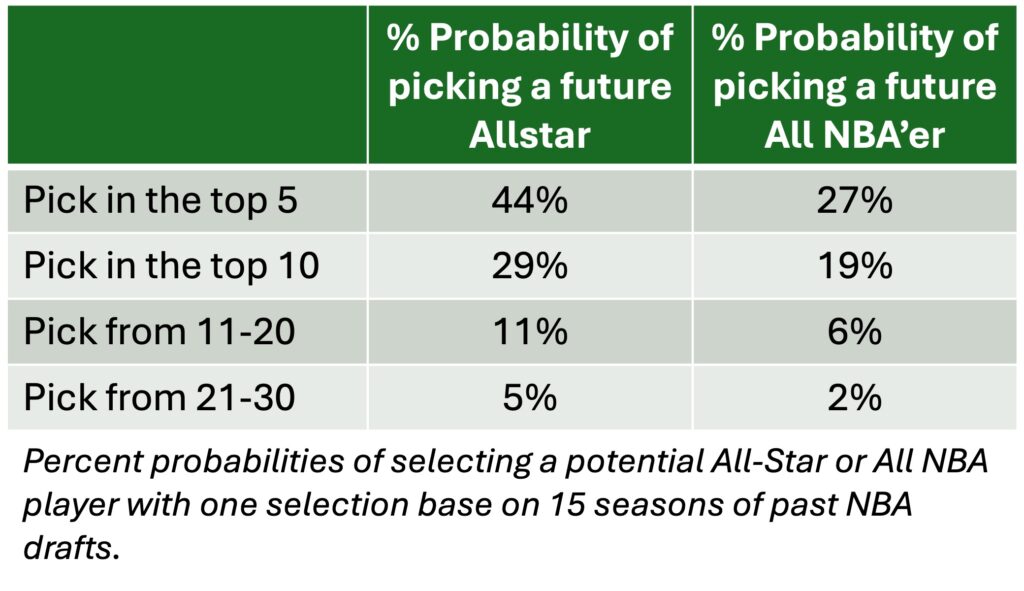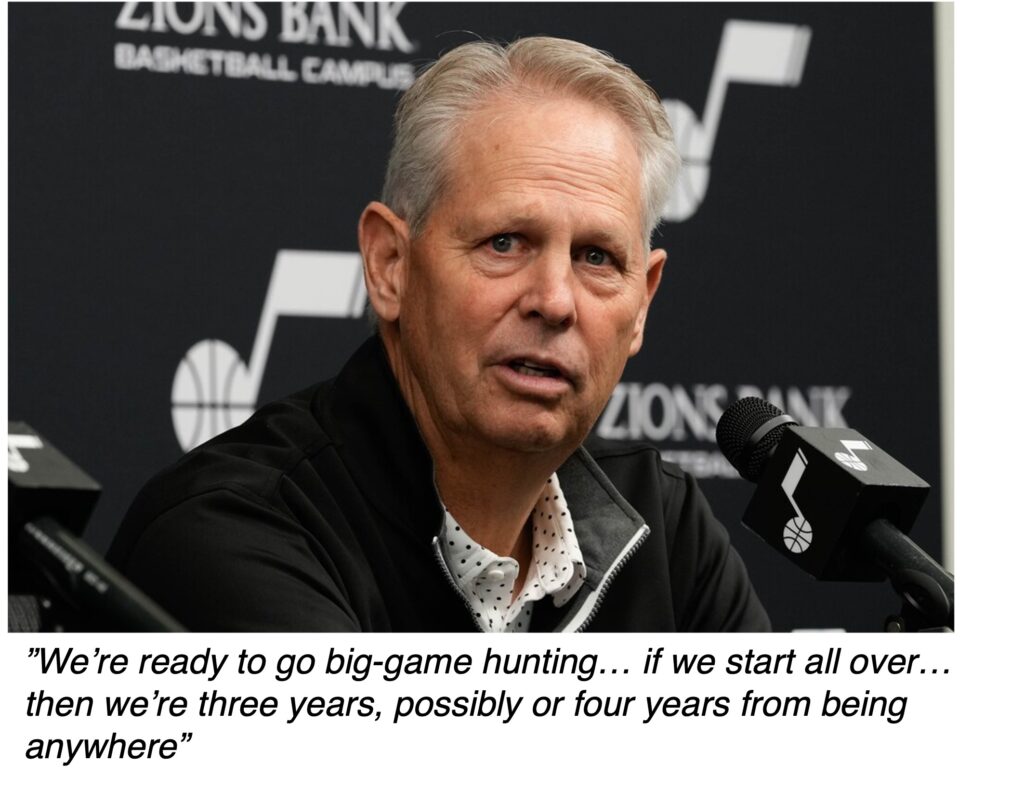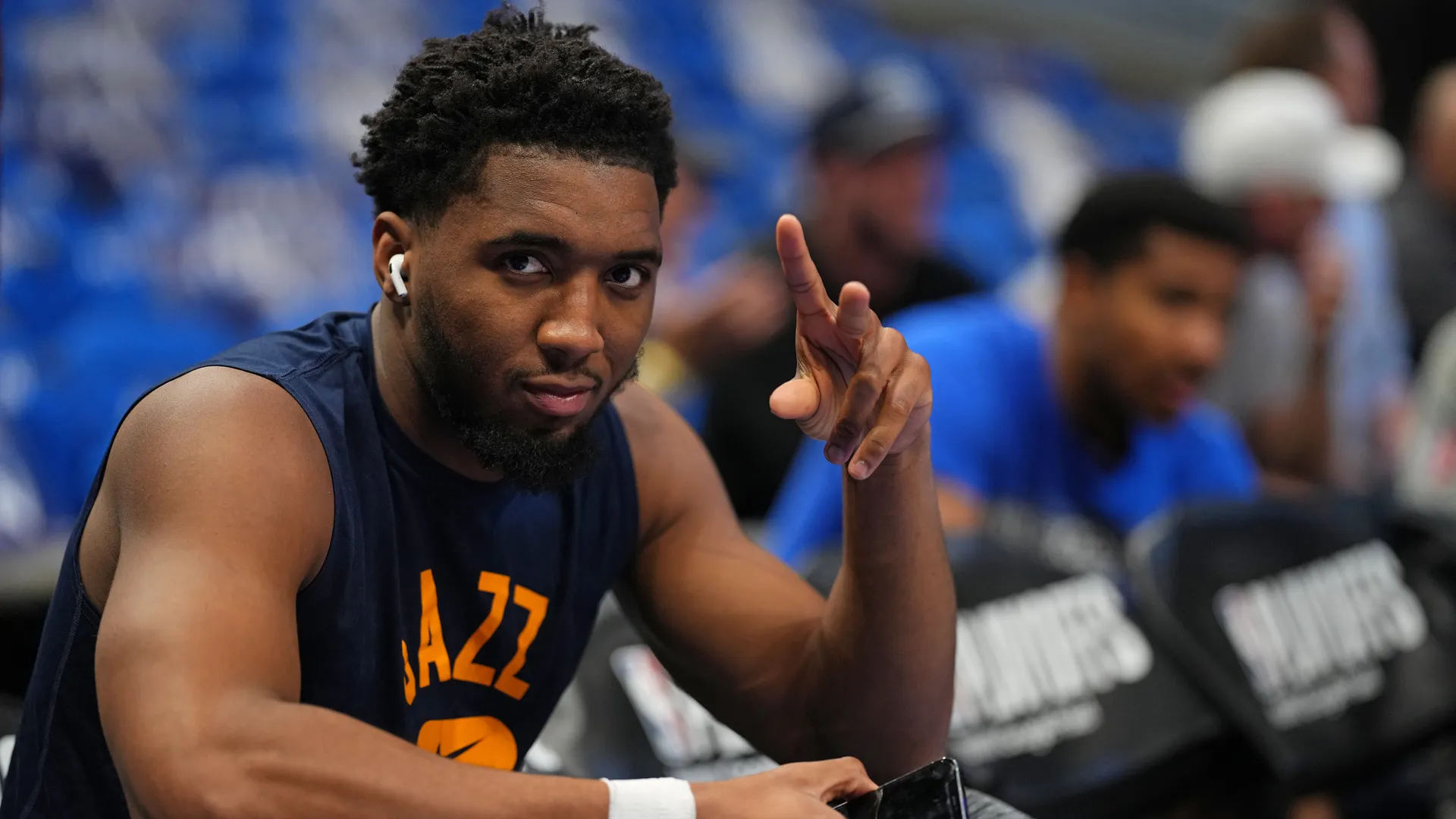Yes, yes… I know, and I apologize. I see we’ve included the word “grading” in our headline—the cheapest, most over-used click-bait teaser in the books. But I assure you… any possible exploitation of your human nature was not intentional. It just seemed an apt title.
The Jazz are now several years into this rebuild. They’ve made picks, they’ve gone hunting, and they’ve lost a lot of games. We thought it would be a good time to check in on this great and sad experiment. Oh, and did we mention were handing out grades too! Sorry, again.
First, let’s reset the groundbreaking of the reconstruction: On July 6th 2022, the Utah Jazz put their hard hats on, thrust their ceremonial golden shovels into fresh ground and traded multi-season All-NBA and NBA Defensive Player of the Year center Rudy Gobert to the Minnesota Timberwolves. In return, the Jazz received three future first-round picks, draft rights to Walker Kessler (2022 first-round draft pick) and players that included the talented shooter Malik Beasley and hustler Jarred Vanderbilt. That seemed like a boatload.
A month later, the Jazz traded current all-star and multi-season All-NBA ‘er Donovan Mitchell to the Cleveland Cavs. The Jazz received in return Collin Sexton, Lauri Markkanen, Ochai Agbaji (2022, 14th draft pick), and three first round draft picks. That also seemed like a boatload.
The Jazz also moved Royce O’Neale and Bojan Bogdanovic in the teardown, picking up another first round pick and Kelly Olynyk. Then Mike Conely and others were moved for yet another first-round pick.
And when the dust had settled, the old Jazz, who had compiled a record of 294-178 (a winning percentage of 62%) over the previous six years and had reached the playoffs each of those six seasons was gone. And a big hole in the ground with scattered bricks and boards and beams and shingles was left in its place.
Now, more than halfway into their third season of reconstruction, we dig into their progress—our finger on the pulse, ear to the ground and all that. Here goes.
Return from the teardown: A
The objective of any transaction in the NBA is (or should be) to improve your team, in some time frame, relative to what you were before the trade. This can be difficult to achieve when you’re giving up All-NBA players like Mitchell, still in his prime, and Gobert who is just past it. But the Jazz had struck when the iron was its hottest it seemed, acquiring eight future first-round picks in all, scattered from 2023 to 2029, and at least three viable starter-level talents in Sexton, the surprisingly-good Walker Kessler and the budding all-star Markkanen. The return looked good.
Although it was presumed that none of the player acquisitions had ceilings like Mitchell or Gobert, it was still a good group, and the eight draft picks would give the team a fair shot to fill the gap… that was the conventional wisdom
But how good of a shot really? Eight picks seemed like a lot. But what was their value compared to the two-in-the-hand all-stars the Jazz had just given up?
Well, if you do the math—and we did—the odds of hitting on equal replacements for Mitchell and Gobert with those eight picks are quite low, considering where the Jazz would likely be picking. Remember, these picks came from winning teams that aim to continue to win in the future. Two of the picks were high-end protected.
The table below shows the odds of selecting an eventual All-Star or All-NBA Team with one pick depending on a team’s position in the draft.

Now, let’s take a reasonable guess on future draft slots for the eight Jazz picks. We’ll say that two picks fall in the top 10, three picks fall from 11-20, and three more from 21-30—very reasonable. What are the odds of the Jazz picking at least two eventual all-stars or All NBA players in those eight picks in those slots?
Queue Jeopardy theme song.
Whatever you guessed… stated in the form of a question or not… is wrong.
Here is the correct answer. The Jazz would have only about a 30% chance of picking two all-stars and only about an 10% chance of picking two All-NBA players with eight picks in the defined draft-position ranges.
Those are tough odds. But that’s the math folks—probabilities and permutations can be cruel masters.
Now, if the Jazz somehow maneuvered their way into getting two picks of those eight in the top five, their odds of picking at least two all-stars jump to 41% and increase to 16% for picking at least two All-NBA players. Still tough sledding, but getting into the top 5 draft positions matters, it matters a lot (more on later).
So even getting back eight first-round picks is not a slam-dunk to replace your two departing corner stone players—it’s more like a very long three pointer. But we really couldn’t have seen the Jazz getting more than they did in the tear-down deal. The long list of players and the eight picks, which included a top-50 player in Markkanen and a potential top 50 player in Kessler have given the Jazz excellent flexibility in the ongoing reconstruction. That includes the ability to package some of those draft assets (already realized or not) in trades for big names or young building blocks. They would still be in need of sound execution and some luck, but the shelves were stocked, and assets were banked.
Grade for the return on their teardown: A
Rebuild Strategy: C-
From the beginning, Jazz brass have trumpeted a flexible, adaptive approach to the rebuild. They would keep top talent who wanted to stay in Utah (a rare combination, e.g. Markkanen). But they would also evaluate their incoming youth. They’d build from the middle… keep something on the shelf, lose enough games to keep their own top ten protected draft pick, but be ready to strike at golden players via trades and free agency when the opportunities appeared.
The approach seemed a difficult path from the start—a dubious swim lane to attempt to succeed in.
Other small market rebuilding models, using full-on, multi-year tanking, were shining brightly around the Jazz. The table below shows draft results of teams that recently dove headfirst into tanking as the Jazz stayed in the middle. Note the location of the tankers’ picks and ponder the names of the players obtained at those slots (those in bold are already all-stars). We told you draft position matters. Small market teams that are forced to grow through the draft need top five picks. And sadly, in this NBA, that requires that you try to lose.

The Jazz chose another path, however. A feasible (see are take on rebuilding from the middle) but less probable road to recovery. The strategy has left them in the tail end of the lottery in the last two drafts and with no big game to show from their build-from-the-middle approach.

Ainge and team believed that carving out a faster path than a complete and long tank journey was possible and preferable. Heck, he’d done it before in Boston. But such beliefs may have been naïve–difficult to believe with Ainge’s experience, but maybe. Utah, in the basketball world, or any other world, is not Boston.
So, the Jazz adjust now in this third season and are engineering a tank—and quite successfully we add. We give the team leadership credit for this shift in approach. But making in earlier would have been better. Grade: C-.
Execution of the rebuild to date: C+
The Jazz have made five first-round draft picks in the rebuild seasons (three of those obtained in the Mitchell and Gobert trades), none higher than 9th. Keyonte George (14th pick) and Isaiah Collier (29th) look like they will be NBA players. The book is out on injured Taylor Hendricks (9th). Sensabaugh (28th) could go either way. Cody Williams has looked like a big miss for a 9th pick… like a big swing, spin a round twice, bat flying through the infield whiff. Cody is statistically one of the worst players in the league right now. But we’re only one or two years in on these guys so they could still defy our initial impressions–even Williams we suppose. It looks, however, like the Jazz have not yet hit the home run everybody is hoping for—they probably don’t have an all-star in the bunch.

But the odds were such that they would likely not get an all-star from where they were making those five picks. I don’t think the Jazz have drafted poorly. They are getting about what you would expect from where they were picking. They may even be beating the odds with Collier looking like a find at 29 and Filipowski performing above his weight as a second-round pick.
We also like the Jazz playing the dog-at-the-table roll at the trade deadline this season, lapping up crumbs from the fierce trading that was going on above them. The second round picks they acquired along with serviceable K J Martin, for basically nothing, are small additions but are signs that the Jazz are diligently looking for any advantage in the rebuild.
The Jazz’ plan to poach top veteran talent via trade and free agency for a quick return to winning, however, has been a complete flop. There is no big game in the ice locker.
Execution grade: C+
In conclusion…
The Jazz acquisitions to date are not world beaters, but some of them boys can definitely play. Kessler shines brightest having shown, with his improvement this season, that he can be part of a new foundation.
And the Jazz have plenty of arrows still in the quiver.
But they need to hit. They need to get into the top 5 or better in the draft. And, we’re sorry to say, they need to have multiple swings in that range. It is very unlikely that any of the traded-for picks will give them a shot at the top five. So, sadly, the Jazz need to rely on their own pick. That means they need to keep losing. Get lucky this July, tank again in 25-26 and then you move onward and upward. It’s a drag to lose, we know. But it’s their best shot at building a new winner, even if that winner is several years down the road.
The Jazz final grade for their rebuild to date is a C+.
But get the team Cooper Flagg and one of the Boozer boys in 2026 and we’ll move this thing up to an A. We promise.
